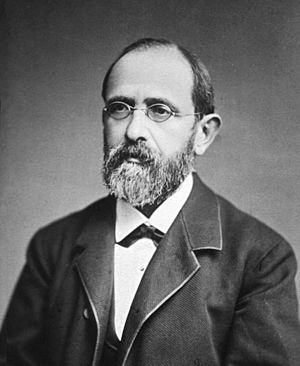Rudolf Heidenhain facts for kids
Rudolf Peter Heinrich Heidenhain (born January 29, 1834 – died October 13, 1897) was an important German scientist. He studied how the human body works, which is called physiology. He was born in a place called Marienwerder, which is now Kwidzyn in Poland. His son, Martin Heidenhain, also became a famous scientist who studied the body's structure.
Contents
Rudolf Heidenhain's Education and Work
Rudolf Heidenhain studied medicine at the Universities of Halle and Berlin. After he finished his studies, he worked in Berlin with another scientist named Emil du Bois-Reymond.
In 1856, he went back to Halle and worked in the lab of Alfred Wilhelm Volkmann. While there, he helped make better a way to measure how much blood is in the body.
Becoming a Professor
In 1859, Heidenhain became a professor of physiology at the University of Breslau. He stayed there for the rest of his career. Many students came to learn from him. Some of his most famous students were Karl Weigert, Ivan Petrovich Pavlov, and Albert Wojciech Adamkiewicz. His lab was a very busy place, and many important discoveries were made there. These discoveries were often published in a science journal called Pflügers Archiv.
Discoveries About Muscles and Nerves
Heidenhain is well-known for his work on how muscles and nerves work. He also studied how the body produces heat, which is called physiological thermoelectrics.
He showed that muscles can control how much energy they use. They can even "save" energy! Heidenhain found that if a muscle had to work harder (like lifting something heavy), it would use more energy. This energy would turn into heat and movement.
He also discovered that when a muscle was tired, it could still work in a way that saved energy. Heidenhain's research also looked at how much heat muscles make when they move. He could even measure a tiny bit of heat produced during the smallest muscle movement.
Other Important Research
Heidenhain did a lot of research on how glands in the body produce and take in liquids. He studied the stomach's gastric glands, which make pepsin and hydrochloric acid to help digest food.
He also described special half-moon shaped cells found in the salivary glands. These are now called the demilunes of Heidenhain after him.
Studies on Hypnosis
Heidenhain also studied hypnotism scientifically. He was very interested after seeing a public hypnotist named Carl Hansen. Heidenhain looked at hypnosis from a scientific point of view. He thought that hypnosis happened because a part of the brain, called the cortex, was temporarily slowed down. Later, his student Ivan Pavlov continued these studies on hypnosis.
Books and Papers He Wrote
- Historisches und Experimentelles über Muskeltonus, 1856 - A paper about muscle tone.
- Beitrag zur Anatomie der Peyer’schen Drüsen, 1859 - A paper about the anatomy of Peyer's glands.
- Physiologische Studien, 1856 - Papers on physiological studies.
- Studien des Physiologischen Instituts zu Breslau, 1861–1868 - Studies from the Physiological Institute in Breslau.
- Mechanische Leistung, Wärmeentwickelung und Stoffumsatz bei der Muskelthätigkeit, 1864 - About how muscles use mechanical power, produce heat, and change substances.
- Die Vivisektion im Dienste der Heilkunde, 1879 - About using vivisection (animal research) to help medicine.
- Der sogenannte thierische Magnetismus. Physiologische Beobachtungen, 1880 - About what was called animal magnetism (hypnosis).
- Die Vivisektion im Dienste der Gesundheit, 1884 - About using vivisection to help health.


